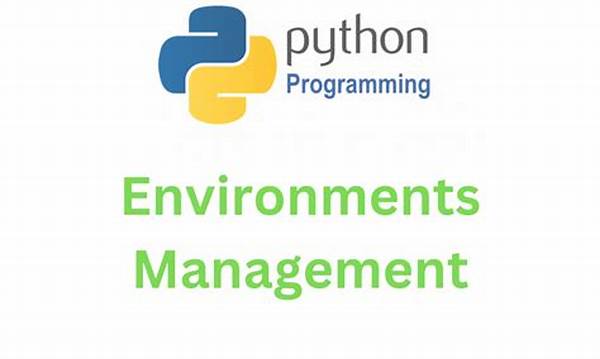In the modern world of software development, effectively managing Python environments is crucial for developers. The complexity of projects often requires different dependencies and versions of Python, which can lead to conflicts if not managed properly. Luckily, there are several powerful Python environment management tools that help developers manage their projects’ environments with ease. These tools not only streamline the workflow but also prevent potential issues arising from dependency conflicts, ensuring a smoother and more productive development process.
Read Now : Top Mini Computers For Productivity
Importance of Python Environment Management Tools
Python environment management tools play an essential role in simplifying the task of managing different Python versions and dependencies across multiple projects. These tools allow developers to create isolated environments, ensuring that each project has access to its specific dependencies without affecting others. For instance, if one project requires a certain library version and another project needs a different version, using these tools ensures that both can coexist independently. This is particularly beneficial when working on projects that have different requirements or need to maintain compatibility at varying levels of a Python ecosystem.
Moreover, Python environment management tools streamline the setup process for new projects or when collaborating in teams. They allow developers to easily reproduce the same environments on different machines, ensuring consistent behavior across development and production systems. This minimizes the risk of running into unforeseen problems when deploying projects. Furthermore, using these tools aids in maintaining a clean and uncluttered global Python environment, which is critical for long-term maintainability and organization within a development workflow. Overall, these tools contribute significantly to enhanced efficiency, making them indispensable for any serious Python developer.
Popular Python Environment Management Tools
1. Virtualenv: A widely-used Python tool that creates isolated environments. With virtualenv, you can work on multiple projects simultaneously, each with its own dependencies, without conflict.
2. Conda: Not just a package manager, Conda manages environments too. It’s particularly favored for data science projects due to its ability to handle non-Python libraries.
3. Pipenv: As the recommended packaging tool by the Python community, Pipenv simplifies managing dependencies and virtual environments, encapsulating the power of Pip and Virtualenv.
4. Poetry: Focused often on dependency management, Poetry also creates isolated environments, simplifying Python environment management.
5. Pyenv: Useful for managing different versions of Python itself, Pyenv allows developers to switch between different Python versions effortlessly.
Streamlining Workflow with Python Environment Management Tools
Python environment management tools are fundamental in streamlining workflows for Python developers. These tools automate the process of environment creation and management, ensuring that the setup is efficient and error-free. By defining dependencies in a single configuration file, these tools automatically install necessary libraries when setting up a new environment, which reduces manual installation errors and saves time.
Moreover, when sharing projects with others, developers can include these configuration files along with their projects, allowing collaborators to replicate the same environment seamlessly. This ensures consistency in development and avoids version mismatch issues that can lead to unexpected behavior in the code. Consequently, the use of Python environment management tools becomes invaluable when dealing with team projects, automating builds, or deploying applications at a larger scale. Their capability to handle complex dependency management tasks with ease is what makes these tools an integral part of modern Python development practices.
Best Practices for Using Python Environment Management Tools
1. Consistent Versioning: Always specify precise versions of each dependency to avoid unpredictable outcomes in different environments.
2. Isolation is Key: Use isolated environments even for minor projects to prevent any global dependency conflicts.
3. Regular Updates: Periodically update your dependencies and tools to catch any issues early on and ensure security patches are applied.
4. Configuration Files: Use configuration files (like `requirements.txt` or `Pipfile`) for keeping track of dependencies, aiding in replicability.
Read Now : Visual Storytelling Strategy Development
5. Platform Considerations: Be aware of any platform-specific dependencies and ensure compatibility across different operating systems.
6. Documentation: Clearly document environment setup procedures for other developers to follow, ensuring easy project onboarding.
7. Automation: Automate environment setup using scripts to avoid manual setup errors and boost productivity.
8. Avoid Global Installs: Limit the use of global installations to tools that are truly needed, reducing the risk of version conflicts.
9. Testing in Environments: Conduct tests within your isolated environments to ensure that your code functions as expected in the intended setup.
10. Backup Configs: Regularly back up environment configuration files to prevent data loss and ease recovery if necessary.
Challenges and Solutions in Python Environment Management
Managing Python environments can come with its fair share of challenges. One major challenge is dealing with dependency conflicts. With numerous libraries often relying on different versions of the same dependencies, ensuring compatibility can become unwieldy. Python environment management tools provide solutions by allowing developers to specify precise versions and dependencies within isolated systems, thus preventing conflicts.
Another challenge is maintaining consistent environments across multiple development and production stages. This issue is addressed by using configuration files that ensure consistency, removing the manual overhead of installing and managing dependencies at each stage. Furthermore, onboarding team members to a project can be complex if environment setups are not documented. Python environment management tools mitigate this by allowing for clearer documentation and automated scripts that set up the environment with minimal effort from new developers, thereby reducing onboarding time and confusion.
Implementing Python Environment Management Tools
Implementing Python environment management tools in your workflow can be incredibly beneficial, yet it requires a consideration of various factors. Firstly, it is important to carefully evaluate which tool best fits your project’s specific needs. For instance, Conda might be more appropriate for data-intensive projects, while Virtualenv could be more suited for smaller, less complex applications.
An effective strategy is to ensure that all project dependencies are correctly documented and easily accessible through a single file, like `requirements.txt` or `pyproject.toml`. These files serve as blueprints for the environments your projects need, and can be easily shared and replicated on other machines. Additionally, it is vital to integrate regular updates and maintenance into your workflow to ensure that all tools and dependencies are kept current and secure. This proactive approach to environment management can help prevent most issues and enhance overall productivity.




